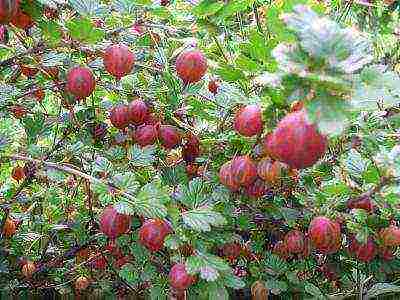Content
- 1 The best wine grape varieties
- 2 The best white varieties for winemaking
- 3 What are the best varieties for red wine
- 4 What is the difference between wine grapes and table grapes?
- 5 Grape varieties for private wine making
- 6 The best early wine grape varieties for the Moscow region
- 7 How to grow grapes for wine?
- 8 Stages of wine making
- 9 Grape varieties from which wine is produced
Some gardeners manage to make wine from almost every available grape variety. However, the technology of wine production involves the use of certain varieties of culture, filled with a whole bunch of aromas. The most popular white and blue wine varieties are discussed in this article.
The best wine grape varieties
The grapes from which juices and wine are made are called technical. The characteristic of the bunches looks modest in comparison with the table species:
- medium to small size with densely packed fruits;
- the average weight of the hand is 120-150 grams;
- high content of juice (75-85% by weight of the berry);
- the sugar content exceeds 18%.
Wine grapes bear fruit well and consistently. This is facilitated by the increased resistance of plants to fungal infections and pest attacks. Next, we will find out which variety is best suited for winemaking.
The best white varieties for winemaking
Chardonnay
Chardonnay is a world-famous technical grade of Western European origin. It is not possible to thoroughly find out the pedigree, but there is an opinion that the variety appeared thanks to the crossing of Pinot noir and Gue blanc.
Berries are processed to produce wines with different flavor notes and fruity aromas. Also, part of the harvest is annually sent for the production of wine materials, which are subsequently used as a champagne flavor enhancer.
Brief characteristics of the plant:
- the bush is medium-sized, although strong-growing lashes are also found;
- the growing season lasts 130-140 days;
- flowers are bisexual, which ensures good pollination;
- conical clusters are loose, weight reaches 900-1000 grams;
- white-green berries are set off with a golden tint;
- fruit shape - rounded slightly elongated;
- grape weight - 12-15 gr., each contains 2-3 seeds;
- sugar content - 18% with an acidity of 8-12 g / l;
- yield - 8-12 t / ha;
- the culture is frost-resistant, can withstand temperatures up to minus 20 °.
Chardonnay tolerates drought, with an excess of humid environment, the fruits can rot. Resistance to mildew and powdery mildew is moderate.
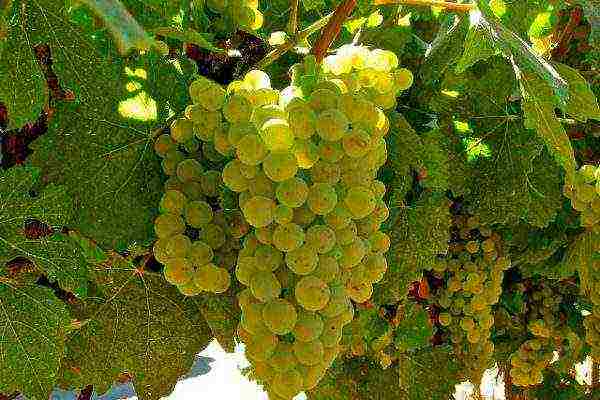 Chardonnay variety
Chardonnay variety
Bianca
Wine material from Bianchi has an unrivaled taste with notes of vanilla and almonds. For the production of table, semi-sweet and other wines, blending with other juices with a low sugar content is used. This helps to avoid the sweetness that is characteristic of this grape.
The grape was bred in Hungary, the parents are Villars Blanc and Chasselas Bouvier.
Brief characteristics of the plant:
- early ripening period, growing season - 110-120 days;
- medium-sized bush;
- cylindrical brushes, weight 90-120 gr .;
- fruits are small and medium, weight 1.5 g .;
- the shape of the berries is round, slightly elongated, the color is greenish-yellow;
- the skin is thin, the taste is harmonious, filled with a bouquet of aromas;
- the crop does not lose its presentation on the vine after the onset of full maturity;
- sugar content - 20-28% with an acidity of 7-9 g / l;
- there is a high resistance to mildew, gray rot, oidium, tolerance to phylloxera;
- frost resistance - up to minus 27 °.
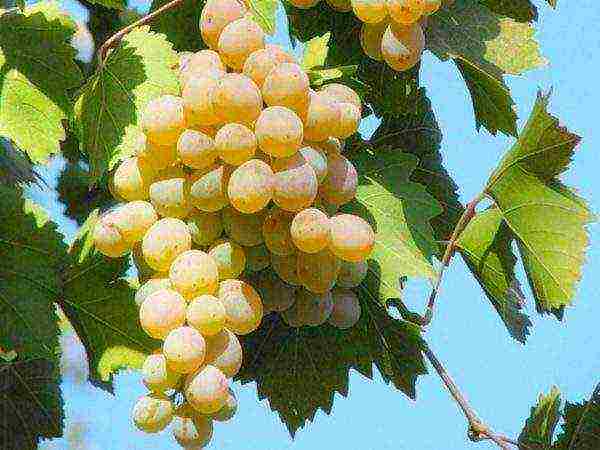 Bianca on the vine does not lose its appearance even after full maturation
Bianca on the vine does not lose its appearance even after full maturation
Muscat
Medium-early ripening muscat with a growing season of 130-140 days. Muscat is one of the oldest varieties originating from Syria, Arabia and Egypt. The peculiarity of the culture is the ability to accumulate a high level of sugar (up to 25% with an acidity of 6.5-7 g / l).
A brief description of:
- medium-sized bush;
- the weight of a conical bunch is 100-450 grams;
- berries sit tightly on the brush, the weight of one is on average 4 grams;
- the taste is saturated with nutmeg;
- yield - 66-109 c / ha;
- disease resistance is low.
Excellent marketability and taste outweighs poor survival in adverse climatic conditions. Grapes immediately react to a lack of moisture and its excess, does not have resistance to low temperatures, and requires potassium dressing.
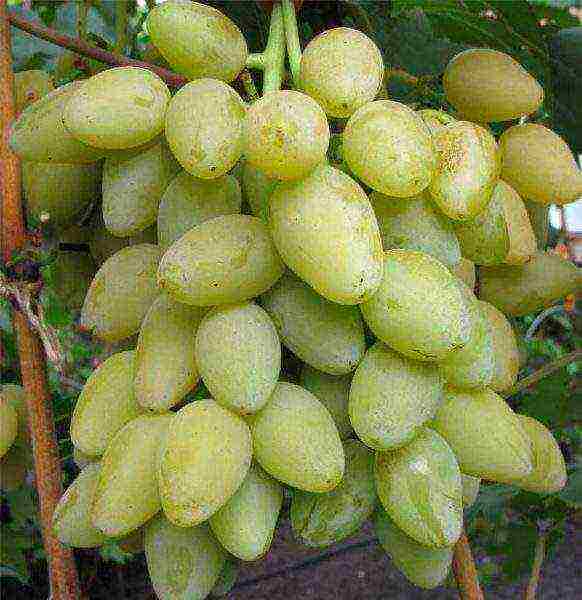 Muscat close up
Muscat close up
Sauvignon Blanc
The variety was obtained by crossing Chenin Blanc and Taminer. Thanks to its excellent taste, balance of sugar and acidity, grapes are recognized all over the world. The peculiarity of the culture is the timely harvest. When overripe, the berry loses its properties and taste, becomes unsuitable for winemaking.
A brief description of:
- growing season 130-135 days;
- bushes are medium-sized, but powerful enough with a developed root system;
- clusters of small size, weight is 75-120 grams;
- the berry is small, the color is greenish-white with a waxy coating (each contains 2-3 seeds);
- low yield;
- sugar content - 18-23% with an acidity of 6.7-11 g / l.
The culture shows weak resistance to powdery mildew and gray mold, tolerance to mildew. In growing conditions with high humidity, shedding of flowers is noted. Soils are preferable with the content of clayey interlayers, as well as gravel and sandy inclusions.
 Sauvignon Blanc - the main thing is not to wait for the berries to ripen so as not to spoil the wine
Sauvignon Blanc - the main thing is not to wait for the berries to ripen so as not to spoil the wine
Riesling
The variety, donated by nature itself, is considered the king in winemaking. High-quality wines are made from berries with excellent taste, which are filled with different notes and shades.
A brief description of:
- growing season - 140-150 days;
- dense clusters, weight 80-100 gr.;
- berries are yellow-green with a bluish tinge, weight 1.3-1.5 g., rounded shape;
- the skin is dense, but thin;
- frost resistance up to minus 20 °;
- full ripening of fruits occurs in October-November;
- sugar content 18% with acidity 9-11 g / l;
- disease resistance is low.
Fruiting grapes on different soils, but the more acceptable is the land with a lime content.
 Riesling has low disease resistance
Riesling has low disease resistance
Pinot Blanc
The representative of the Pinot family is characterized by multifaceted taste, it is used to make still, sparkling and dessert wines. Burgundy is the birthplace of the plant, but today almost all European countries and other regions can boast of high yields.
A brief description of:
- growing season - 140-150 days;
- clusters of medium density weighing 85-150 grams;
- berries of a round shape, yellow-green color, weight 1.4-1.7 g;
- the average sugar content reaches 20%.
The peculiarity of the variety lies in the low content of acid and aromatic substances, as a result of which Pinot Blanc is recommended for making wine, which should be consumed by young people.
 Ripening period Pinot Blanc - 150 days
Ripening period Pinot Blanc - 150 days
What are the best varieties for red wine
Pinot noir
Black fruitful grapes ripen in 141-151 days. There is no reliable information about the origin, but Traminer and Pinot Meunier are considered the likely parents. The bush is medium-sized with an unusual color of the lower leaves (green with a red tint). The flowers are bisexual, there are no problems with pollination. A bunch of small sizes, weighing 66-120 grams, the shape is often cylindrical. The berry has a pleasant taste, colorless juice, balanced sugar content. Its shape is round, the color is dark blue.
The yield of Pinot Noir is 50-60 c / ha.The plant is vulnerable to phylloxera, tolerance to gray rot, powdery mildew is manifested.
Grapes develop poorly on flat and low relief.
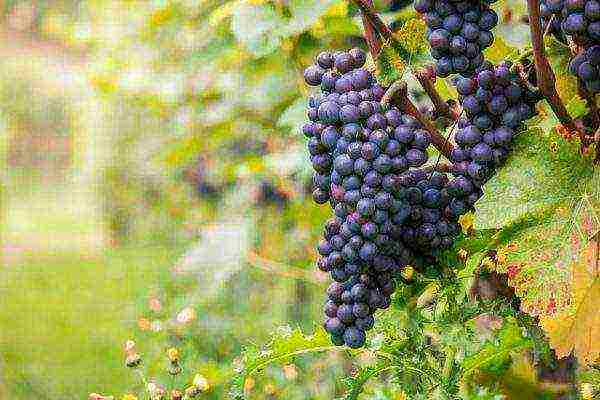 Pinot noir is vulnerable to phylloxera and gray rot
Pinot noir is vulnerable to phylloxera and gray rot
Saperavi
A very old Georgian grape variety with dark blue berries. Saperavi vegetation period is 150-160 days, harvesting begins in late September - early October. The bush is beautifully hung with wide-conical bunches with small grapes, the weight of one is 90-100 gr. The berry is very juicy with a harmonious taste, its weight barely exceeds 1 g. Each contains 2-3 seeds.
The plant has a weak resistance to mildew, oidium, at high humidity it is affected by gray rot. In comparison with other varieties, it is less likely to be damaged by a leafworm.
The yield of Saperavi is 90-110 kg / ha. The culture is frost-resistant, survives the winter without shelter at a temperature not exceeding -20 °.
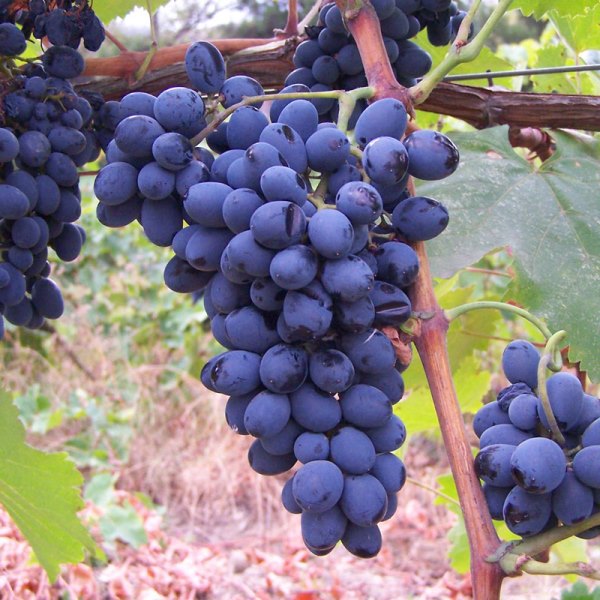 Saperavi is a frost-resistant variety
Saperavi is a frost-resistant variety
Cabernet Sauvignon
Cabernet Sauvignon berries are very juicy with a balanced taste, shaded by a hint of currant. The variety was bred in France, but is now cultivated in many countries of the world. Technical ripeness occurs in 143-165 days. The bunch has the shape of a cylinder, the weight is 70-80 grams. Each berry contains 1-3 seeds. The skin is dark blue in color of medium density, which ensures good preservation and transportability of the fruit.
Productivity - 55-60 c / ha. There is an increased resistance of the culture to mildew and gray rot. In comparison with other varieties, it resists phylloxera, leafworm attacks better.
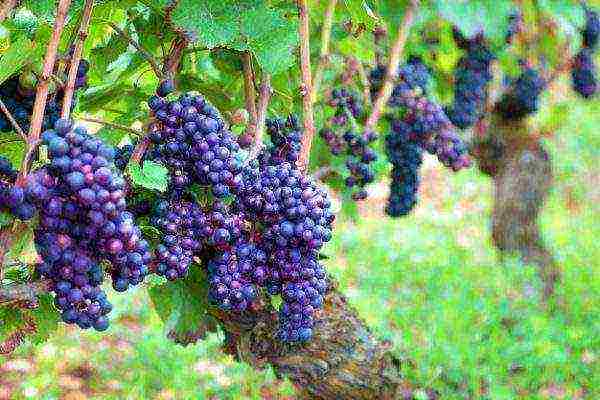 Cabernet Sauvignon is ideal for winemaking
Cabernet Sauvignon is ideal for winemaking
Cabernet Franc
Technical ripeness occurs in 145-160 days. The unusual taste of berries is filled with different notes, in which you can feel raspberries and blackberries. Cylindrical bunches have a dark blue color, the weight does not exceed 70-90 grams. The yield is low (35-40 c / ha), but this is compensated by the good resistance of the plant to mildew, phylloxera.
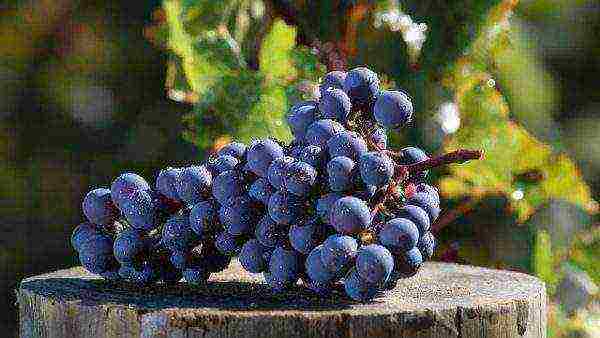 Cabernet Franc variety
Cabernet Franc variety
Merlot
The Merlot variety was bred in France, the intended parents are Cabernet Franc, crossed with Magdalene and Noir de Charente. The clusters are medium in size and density, have a dark blue color with a characteristic waxy coating, weighing 110-150 grams. The taste is balanced with a touch of nightshade.
The grapes ripen in 152-164 days. The plant shows average resistance to powdery mildew, phylloxera, mildew. Frost resistance - up to minus 15-17 °.
 Merlot has medium frost resistance and can withstand temperatures down to -15
Merlot has medium frost resistance and can withstand temperatures down to -15
Sangiovese
Italian thermophilic technical grape with a vegetation period of 145-160 days... The bushes are medium-sized, the flowers are bisexual, the clusters are cylindrical of medium density, weighing up to 100 grams. There are many clones that have slightly different parameters of the berries (0.7 - 1.3 grams). The flavor of the fruit, saturated with different notes, adds sophistication to any drink.
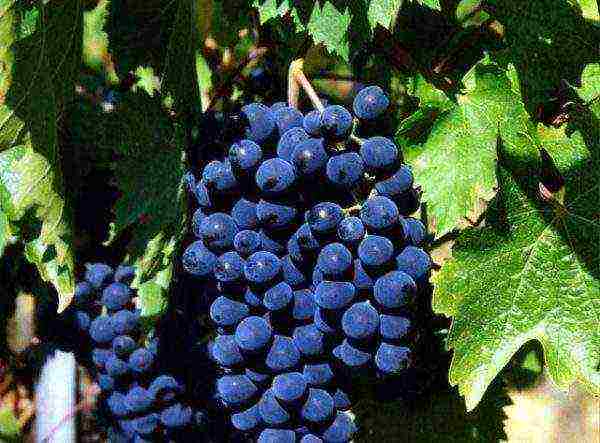 Heat-loving Sangiovese variety
Heat-loving Sangiovese variety
Syrah
The variety is resistant to cold and high temperatures, but does not tolerate strong winds and drought. Taste qualities meet the requirements of technical varieties of grapes, however, it cannot boast of a high yield (30 c / ha). The juice of the fruits of mature plants is saturated with a beautiful dark purple hue and density. Fruit ripening period is 145-158 days. The weight of the shirokokonicheskaya bunch is within 80-120 gr.
Syrah is very capricious to weather conditions and requires a lot of light and heat.
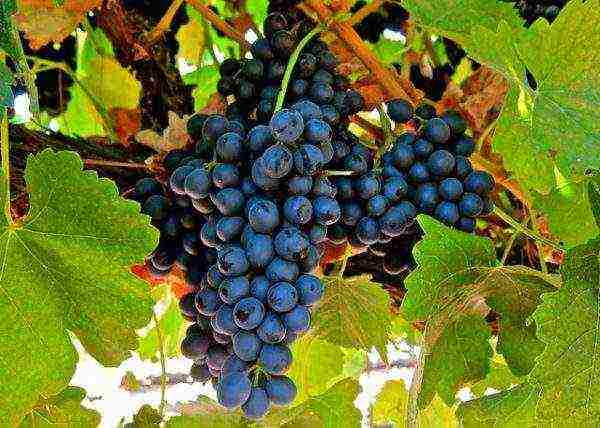 late-ripening Syrah grapes
late-ripening Syrah grapes
Carmenere
The grape belongs to the old French varieties with a growing season of 152-165 days. Currently, it is widely cultivated mainly in Chile, it is considered the pride of the country. The bushes of the plant are vigorous, the bunch can be in the form of a cylinder, broad-conical and shapeless, the weight is 75-100 grams.
A medium-sized berry barely weighs 1 g, but the pulp is very tasty, sweet, but without sugary.The beautiful dark purple color makes it possible to produce wines from pink to dark in color.
Carmenere is very sensitive to weather conditions, cold, shows low resistance to diseases. However, the grapes survived the phylloxer.
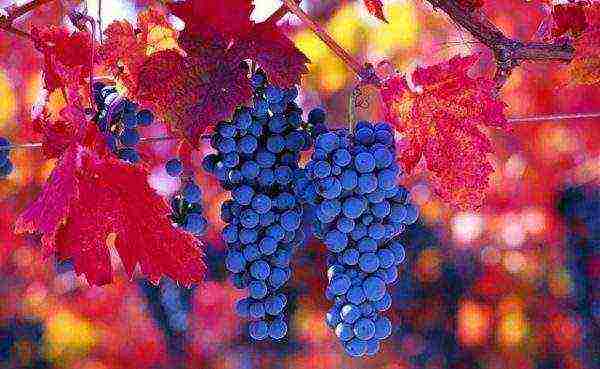 French Carmenere
French Carmenere
Mourvedre
A late-ripening plant native to Spain. The bushes are well developed, have a strong vine and root system. Leaves are medium in size with a characteristic three-lobed shape. Dark blue berries are often rounded, but can take on a slightly oval shape, the parameters are average. Productivity with low watering is up to 60 kg / ha, but with regular irrigation it can significantly increase. The bunches are formed in the form of a cone or cylinder, the berries are tightly pressed against each other.
The culture has a weak resistance to fungal infections, but it tolerates prolonged drought rather tolerably, and high requirements are not imposed on the type of soil when planting.
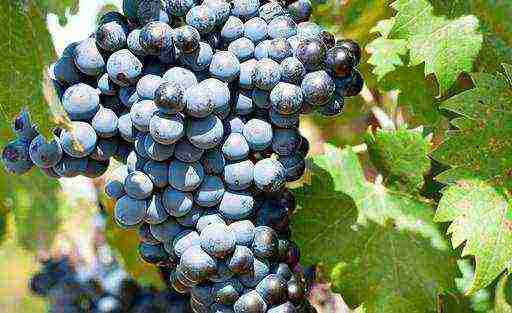 Dense Mourvèdre berry
Dense Mourvèdre berry
Grenache
A versatile variety, but most often the fruit is used to make grapes and juice. The variety is one of the most abundant on the planet due to the versatility of the vine. The grapes are very thermophilic, easily tolerate drought and heat. There are also no high requirements for the soil when planting seedlings. Productivity in dry conditions is high - up to 20 kg / ha. Features of berries: low acidity, juiciness, ruby color, rich aroma.
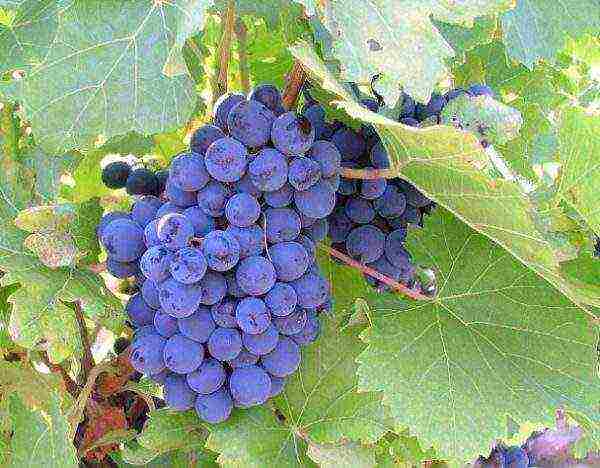 Drought-resistant Grenache variety
Drought-resistant Grenache variety
Each variety has unique qualities that give the wine a unique shade and aroma. Before choosing a variety, it is necessary to clarify the compatibility of the wine material with juices of other varieties, then at home you can create an exquisite drink, and most importantly - an exclusive one, the taste of which will remain in your memory for a long time.
Foreword
Many people believe that all grape varieties for wine production grow exclusively in the south, but even in Altai today, many owners grow strong healthy vines with large clusters of juicy berries.
What is the difference between wine grapes and table grapes?
Harvests from most fruit crops are intended for direct consumption, whether raw or after heat treatment. But there are also individual plants that are bred for industrial processing, that is, in fact, raw materials. For winemaking, for example, special technical grape varieties are used. Let's see what is their difference from canteens, especially since both of them can be eaten.
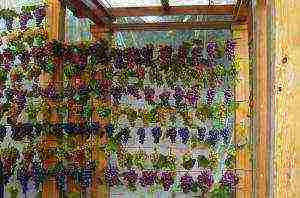
On the table, we are used to seeing large brushes with large juicy berries. As for the latter, preference is given to the most fleshy, thin-skinned, preferably pitted. On the palate, the berry can be both tart and sour, but always sweet, since fruits are usually served for dessert. The sugar content in these grapes is usually in the range of 13-17%. The table variety is the more appreciated, the more fruits on the clusters, the larger the berries themselves. It is logical that grapes require a lot of sun for full ripening and accumulation of juice.
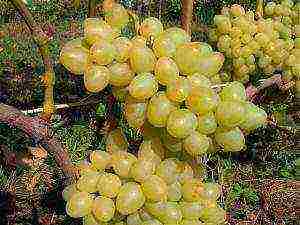
Quite different requirements for technical varieties, which, by the way, can also be eaten. Their main and main difference is the size of berries and brushes, which are much smaller than those of table varieties. When breeding such grapes, special attention is paid to juiciness and taste, as well as the amount of sugar, which should be in the range of 18-20% or more. The berries should contain a lot of coloring, as well as extractives, which affect the color saturation of the wine, as well as the bouquet of taste and smells. It is these substances that make some varieties unsuitable for human consumption, since they give the berries an unpleasant aftertaste.
Grape varieties for private wine making
In fact, wine can be made from any fruit and berry, as long as the sugar content is high enough.However, the taste of wine largely depends on the mineral and vitamin composition of the fruit pulp. If we take grapes as an example, it becomes clear that some varieties can give home wine only an exceptional sweetness, there may be some astringency, but not a rich bouquet of flavors. That is why many owners try to grow not only dining rooms, but also grape varieties for winemaking.
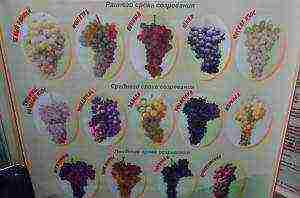
It should be remembered that industrial crops require the same amount of space as conventional fruit crops, but their yield can be quite low. When growing table varieties, it is productivity that is most appreciated, that is, the number of bunches from each bush, while wine varieties should have a high sugar content of berries, and not the yield of the vine.... In areas close to the north, where the sum of active temperatures rarely exceeds 2000–2200 (in particular, in the conditions of the Moscow region), only early ripening frost-resistant varieties ripen.
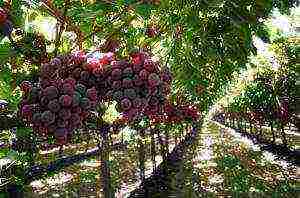
But even with grapes bred specifically for the north, the berries would not have gained sugar with a large number of clusters on one bush. With low solar activity, the metabolism in the vine is somewhat slowed down, due to which the distribution of trace elements in the hands may be insufficient. Realizing this, experienced gardeners carry out pruning twice a season, which is called normalization. The first is carried out when the berries reach the size of a pea, at which time up to 50% of the brushes should be removed. The second pruning is performed at the end of July, leaving only 1-2 brushes on each shoot, depending on the size of the vine. If this is not done, the quality of the grapes will be poor.
The best early wine grape varieties for the Moscow region
In regions where the frost-free period lasts from 130 to 150 days, the vine should yield no later than 110-115 days from the moment the eyes open.... Few varieties have such early maturity, and most of them are among those that grow in the south, but they cannot be grown in the north, they will not take root. For many years now, work has been going on to ensure that vineyards appear in the Moscow region and in cold latitudes, from the harvests of which the best wines could be made.
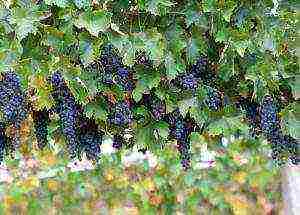
Today, white grape varieties are considered the most adapted to the conditions of the north, such as Elegy, Golden Muscat, Hungarian Crystal and Prim, Odessa Muscat, Pineapple, Magaracha's Gift. But red wine is healthier, and therefore dark frost-resistant cultures appeared: Yubileiny, Livadia black, Fortuna, Germanic Rondo, Rubin Golodrigi and December. The latter variety is universal and can be used directly for food, as well as for obtaining fresh juices, due to the fact that it has large fleshy berries.
Each of these grapes is able to withstand fairly low temperatures and even short-term severe frosts. In particular, the Gift of Magarach perfectly tolerates the cold when the thermometer shows -33, even if the cold lingers. But Elegy and Yubileiny, with prolonged frosts, can lose significant amounts of buds, of which no more than 10% sometimes remain frozen. Most other frost-resistant varieties, without careful covering, lose all buds if the low temperatures are delayed for a couple of weeks.

In the conditions of the Moscow region, among others, uncovered grape varieties are grown, that is, those that tolerate even significant cold snaps quite easily, and, remarkably, are practically not susceptible to diseases. These include Sukribe, Saperavi North, as well as the Amur breakthrough. The latter, along with such varieties as Triumph, Malinovsky and Amethystovy, belongs to the Amur hybrids, bred by domestic breeders for the conditions of the north. These crops are able to withstand frosts down to -32 (Marinovsky) and up to -40 (Triumph).
How to grow grapes for wine?
If you have such a spacious plot that, in addition to an orchard and vegetable garden, there is a place for a vineyard, try to leave the southern side of the plot free. It is there that the vine will receive the most solar heat for active metabolism. As a last resort, you can set aside a strip of land under the southern wall of a residential or outbuilding. In no case do we plant bushes from west to east, then only one side of the vine will be constantly in the shade. The rows of the vineyard should stretch strictly from south to north.
Under the seedlings, we dig a 60x60x60 hole or a trench with the same depth and width, depending on whether you have one or several bush. At the bottom we place a small layer of brick battle (about 20 centimeters). When filling the hole, be sure to add manure and compost to the soil, you can have a little peat, and be sure to sand and fine gravel in small quantities. At the corners of the pit or along the trench on both sides of it, with a step of 60 centimeters, we bury half-meter plastic pipes so that 5 centimeters rise above the ground. Through them we will water and feed the vines.
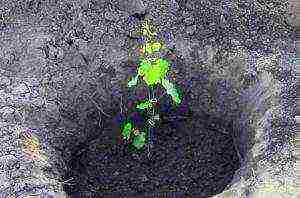
It is preferable to plant grapes with a closed root system in early spring after frosts, if with an open one, then planting can be carried out from spring to autumn.
In order for the vineyard to be fully provided with sunlight, it is not recommended to plant densely bushes. The minimum distance between plants is 2 meters, as for the space between the rows, its width should be at least 3 meters. 30 centimeters west of each row we dig in trellises, from which the growing vine should be easily removed for shelter for the winter. In order for the vineyard to endure the cold with minimal losses, metal arcs are installed over the shoots laid along the rows, onto which a vapor-permeable covering material is stretched.

It is necessary to insulate grapes in the Moscow region gradually, until nothing portends frost, it is better to leave the ends of the greenhouse open. After closing the shelter, you can throw more snow on top. At the end of March, when the snow melts and the ground begins to warm up, we gradually begin to open the bushes. In the afternoon, when the weather is sunny, we remove the covering material, but even before sunset we pull it on again so that at night the plants are protected from possible spring frosts. We return the shoots to the trellises when it becomes completely warm, and no cold snaps are expected.
Rate the article:
(0 votes, average: 0 out of 5)
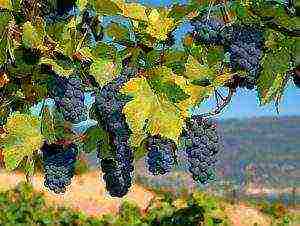
Wine is an alcoholic beverage made from fermented grape juice as a result of its fermentation process.
If the drink is made from other berries or fruits, then it is not considered wine.
Wines come in a variety of colors, flavors, strengths and characteristics. The basis of the wine is grapes. It is he who sets the tone for the drink.
…
A low-quality or unsuitable grape variety will not make a tasty drink, therefore, the basis of winemaking is the cultivation of wine grape varieties.
Making a wine drink is an art that begins with grapes. Winegrowers note that good wine grapes have a certain structure - the berries are usually small, the bunches should not be large, and the juice content in the berry should be more than 80 percent.
The grapes should have a distinct taste, often tart, and the aroma of the berries should be intense.
Find out what are the best grape varieties on our website.
Find out the peculiarities of plum care in autumn here.
Cherry care:
Stages of wine making
Winemaking is divided into two stages:
Grape harvesting, processing, fermentation and clarification;
- Aging, pouring and bottling.
Of course, this is a short description of the stages, since the production technology is complex, and the process takes a long time.
The grapes are harvested at the maximum ripening of the berries. Sometimes picking overripe berries is allowed, since the sugar content should be as high as possible.
White grapes ripen a little later than red ones.
The technologies for the production of red and white wines have some differences, for example, in the pressing time and the stages of pressing the berries.
Grape varieties from which wine is produced
Aligote
The most popular variety. French variety, unstable to aging. The berries are yellow-green, spotted, with red veins, the leaves are dark green.
Aligote wines are light, with a pleasant delicate taste. The variety is suitable for making sparkling wines.
Albillo
Spanish wine variety. The berries ripen and bear poorly. Berries are yellow-green, small. It is used to make high quality wines such as port or Madeira, suitable for the production of sherry.
Aranel
French variety. The berries ripen early, the clusters are dense, green with a golden hue.
Suitable for making white wines with a rich aroma.
Armavir
Hybrid variety. The berries are black with a thick skin. Ripen late. Suitable for making red dessert wines, less often table wines.
Barbera
Italian late ripening variety. The berries are red, with a tart taste and smell. Suitable for long aging red wines.
The wines are aromatic, tart and with a currant flavor. The color of the wine is dark, intense.
Bastardo Magarachsky
Technical grade with small dark blue berries without aroma. It is used to prepare mainly dry wine with a rich bouquet and notes of chocolate, cherries, berries and even rose hips.
The wine turns out to be of a deep ruby color, high quality.
Verdello
Portuguese variety, homeland - Madeira island. The berries are small, greenish with a golden tint. Sweet in taste, with a delicate aroma.
Suitable for making Madeira varieties of wine, as well as for strong and sherry wines.
Viognier
Bunches are small with small round berries of almost white color. The berries have a musk aroma and are not susceptible to aging. White wines are obtained with musky or apricot aromas, quite rich and sweet.
Grenache
Popular variety. There are two types - white and noir (Black). Cultivated white, noir is a very ancient variety with sugar berries. Used for high quality red wines.
It is often used to dilute wines from other grape varieties due to its strong sweetness and pronounced taste.
Varieties of peach varieties can be found on our website.
Mint flowers are widely used in traditional medicine:
Gamay
A French variety suitable for making red wines, mostly dry. The wine is light, with a delicate aroma of berries or fruits.
Gewurztraminer
A white grape variety native to France. A very fragrant variety suitable for the production of sweet wines. The wines have a rich aroma of honey, rose or citrus.
Dolcette
Italian red grape variety. Berries are not susceptible to aging, suitable for red wines that have a pleasant fruity aroma.
Zinfandel
American variety, wines obtained from grapes of this variety are highly alcoholic with a tart sour taste.
The aroma can be with notes of spices and pepper, as well as rose and berries.
Idiveren
Turkish variety. The berries are small, black. It is used in the preparation of light red wines with a fresh, unsaturated aroma.
Cabernet Sauvignon
Perhaps the most famous grape variety. French variety with small dark blue berries. It is used to make a rich red wine with a tart aroma of black currant, chocolate or juniper notes.
Kokur
White grape variety. Crimean variety, resistant to aging. The berries are green, medium-sized, oval. Suitable for the preparation of white dessert wines with a light aroma.
Carmenere
A red grape variety found primarily in Chile.The wine is sweetish, with hints of plum, coffee or black berries.
Cortese
Italian white grape variety. It is used in the production of Piedmont wines, as well as sparkling and champagne. A fragrant light variety, the wines from which have a faint lime or berry aroma.
It's great when birds sing in the garden. Attract birds to your area by making a DIY bird feeder.
How to build a barn, read here:
Leon Millau
A grape variety for the production of red wine. The berries are large, blue-red. The wine is velvety, with a pleasant cherry or chocolate aroma.
Lebanese black
A variety with small berries and a dense bunch. It is used in the preparation of light wines with a velvety delicate taste.
Merlot
A red grape variety as popular as Cabernet.
Merlot wines are soft, with a rich aroma of berries, cedar and chocolate. These are the most fruity wines.
Malbec
French grape variety. The berries are round, blue, the bunch is not dense. The wines are ruby-colored with a strong juicy taste and hints of plum and tobacco.
Muscat white and black
Popular variety, originally from Egypt. Muscat wines are of high quality and rich in nutmeg aroma. The berries are dense, yellow-green, or black with a blue tint.
Nebbiolo
Italian red grape variety. The berry is blue-black, the bunch is small and dense. Wines from this variety are obtained with sourness and notes of herbs, licorice and leather.
Pinot blanc
White grape variety. Suitable for making white wines with pear or apple aromas.
Pinot noir
A red grape variety with the most unusual and complex flavor. Wines from this grape variety include a complex bouquet of flavors of berries, musk and herbs.
Riesling
A white grape variety from which both dry and sweet wines are made.
A noble variety suitable for aging, giving the wine a plum, peach and fruit aroma.
Sangiovese
The most popular Italian variety. Red wine will be distinguished by spice and rich taste.
Sira (Shiraz)
Red grape variety. The wines have a strong rich berry aroma and a dark color.
Tempraniyo
A popular Spanish red grape variety whose wines have aromas of berries and tobacco.
Turiga Nacionall
Portuguese variety from which port is made. Wines can be either dry or fortified, they have aromas of raisins, honey and dried fruits.
Chenin Blanc
French variety, the wines from which are distinguished by the greatest aging. The wines come in many flavors, ranging from berries, honey and pastries to fruits.
Chardonnay
The most famous white grape in the world. Wines made from it can be both light, low-aromatic, and tart with bright notes of berries, sweets and honey.
We have considered only the most popular grape varieties for wine production. In fact, there are thousands of different varieties - original and cultivated. This proves once again that winemaking is not just an interesting occupation, but also a real art!
Find out the interesting features of planting gooseberries.
The specifics of growing raspberries:
